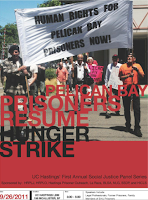This month the California Supreme Court, presiding at UC Hastings, heard oral arguments in People v. Vang, an assault case involving gang expert testimony. Under California sentencing laws, a gang sentencing enhancement requires the jury to decide whether the defendant committed the offense to benefit the gang. Evidence to this effect is often presented through the testimony of gang experts, usually police officers, who testify as to the norms and practices of gangs in general and the gang in question, to show whether a given defendant’s behavior falls in line with gang-related behavior. In Vang, the prosecutor asked the cop/expert two detailed hypothetical questions based on the facts of the assault according to the evidence, then asking the expert whether an assault under such facts would be gang related. By doing so, argued the defense, the prosecutor thinly disguised questions regarding the actual defendants’ behavior as hypothetical scenarios, effectively substituting the testifying cop/expert’s logic and common sense for the jury’s. The government, on the other hand, argued that it would be difficult to define permissible questions that are abstract enough to require the jury to make a “logical leap” and independently assess the perpetrator’s mens rea, while only being provided with guidelines from the cop/expert about the impact of gang membership on the development of such mens rea.
Setting aside the important criminal justice question of the merits and pitfalls of treating police officers as supposedly impartial ethnographers and gang experts—this practice is, by now, modus operandi in California courts—I would like to suggest that there is an even more fundamental issue at the root of Vang: The assumption that gang members are fundamentally different from other people; that their behavior is governed by special rules inaccessible through common personal experience; and, therefore, special knowledge is required to make sense of them and interpret their lifestyle to the ordinary jury member. This assumption did not originate with modern gangs; it is approximately 150 years old.
In 1865, a doctor named Cesare Lombroso wrote the first medical criminology book, titled L’Uomo Delinquente (“The Criminal Man”). Lombroso’s premise, a novelty at the time, was that criminals were innately different from law-abiding citizens, and predisposed to commit crime by virtue of being “atavistic”, that is, “stuck” in a less-developed evolutionary phase. Lombroso gleaned this predisposition from a series of medical findings involving the measurements of inmates’ skulls (based on the then-popular science of phrenology), their bodily and facial features, tattoos, handwriting, and laughter patterns. Pages upon pages of the book included photographs showing the common features of criminals and distinguishing these “special” features from those of ordinary people.
In the years since 1865, we have come to reject Lombroso’s “science”, both in itself and as a measure for establishing criminality (not before making a lamentable detour into the territory of eugenics for several tragic decades). However, the idea that criminals were special, or somehow different from law-abiding citizens, persisted. Much of the criminology of the early 20th century consisted of ethnographies and observations of criminal groups under the assumption that lack of privilege, living in a given neighborhood, or having a certain subset of role models shapes a unique human being, predisposed to commit crime. This literature—much of which was, admittedly, incredibly helpful for understanding phenomena such as juvenile gangs—suggests that, while some human beings are within the realm of the knowable through common sense and life experience, others cannot be understood without the benefit of special expertise.
Today’s California gang members are the new Lombrosian criminals. To curb criminal gang activity, we have adopted special sentencing rules and uniquely oppressive correctional practices. This special treatment goes beyond the mere development of special investigation practices, evidentiary rules and penal technologies; it includes the development of a new body of knowledge that regards gang members as special, their lives and behavior beyond the reach of ordinary human common sense. But we have done more: By examining gang practices as special and unique, through the lens of clinical expertise, we have relegated gang members to the status of incorrigible specimens, who can only be studied, controlled, governed, and suppressed through special, dehumanizing technologies.
The perversity of this approach is evident these days, as the Pelican Bay inmates plan on renewing their hunger strike on September 26th. The hunger strike, which lasted for 21 days in July and received woefully little media coverage, aimed at changing the correctional policies involved in incarceration at the Security Housing Units (SHU) in Pelican Bay. When inmates are identified as gang members, they are subject to a penal regime that consists of complete isolation for 22 ½ hours a day in tiny cells, their only companion often the blearing sound of a television set. Their daily respite from years of solitary confinement is a 90-minute outing in a barren exercise pen surrounded by 15-foot-high concrete walls and a limited sky view. The entrance ticket into the SHU consists of being identified by prison authorities as a gang member, placing the burden of “debriefing”—disavowing and disproving gang membership—on the inmates themselves, most of whom never find their way out of the SHU. Despite consistent findings by social psychologists about the immense, irrevocable harms of subjecting human beings to a regime of isolation, and despite a federal judge’s comment in 1995 according to which such practices “hover on the edge of what is humanly tolerable”, courts have consistently found SHU incarceration practices constitutional.
To add insult to injury, during the July Pelican Bay hunger strike CDCR officials went on record discrediting the strike because it is “led by gang leaders.” This argument is the epitome of Lombrosian thinking. It implies that the public is to disregard the merit in the striking inmates’ claims against the dreadful conditions of their confinement merely because they are (suspected to be) gang members or led by gang authorities. Why would the arguments against solitary confinement and its devastating effects on the human psyche be any less valid just because the humans making them, and subject to them, happen to be (suspected of) belonging to gangs?
Indeed, gangs are unique organizations. So are corporations, hedge funds, motorcycle clubs, cults, schools, military units, and academic departments. Crime has occurred in each and every one of these contexts, and while criminal decisionmaking has required an explication of the social setting for the crime, it has not deprived us of the sense that juries are capable of understanding these microcosms of human experience. Nor has it implied that any of these settings rightfully denies its participants of human status. While belonging to a subculture has important implications as to a person’s behavior, social context, and range of choices, it does not deny the person’s humanity, relegate his or her behavior to a place beyond the realm of the logically accessible, or make him or her less worthy of basic necessities and rights. Gang members may be more difficult to explicate—and empathize with—than people whose lives more closely resemble that of the average jury member, but they are people, just like prosecutors, jurors, and prison officials. As such, their lives are not completely beyond the realm of reasoning, understanding, and empathy. As we follow up on the upcoming hunger strike, we would do well to educate ourselves on the merits of the inmates’ demands and remember that the measure of a society is the dignity with which it treats its weakest members.






